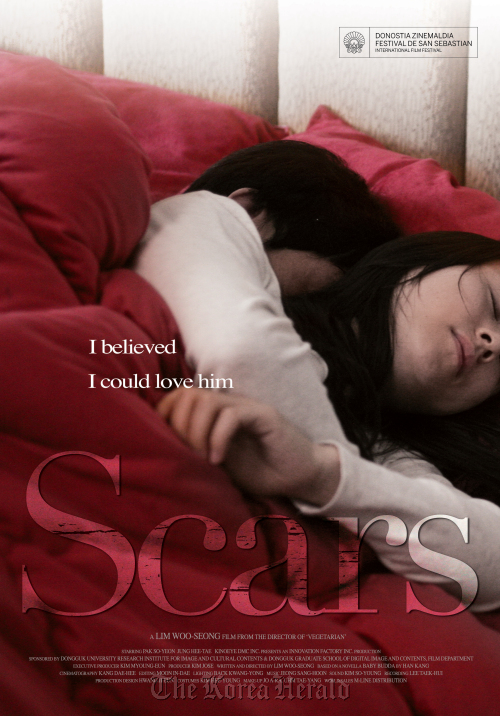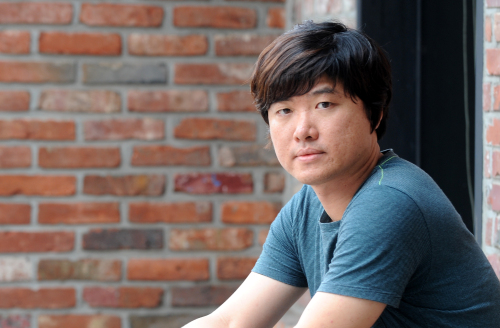Talking about making films and living his dream, director Lim Woo-seong frequently used the word “Magic.”
“Making movies was always a distant dream that just seemed to belong to some other part of the world,” said director Lim Woo-seong, whose second film, “Scars” has been officially invited to Zabaltegi-New Directors section of the 2011 San Sebastian International Film Festival.
“It’s magical that I’ve actually made two films. And it was magical while I was doing it. It was like, ‘wow, so I get to do this after all.’”
“Making movies was always a distant dream that just seemed to belong to some other part of the world,” said director Lim Woo-seong, whose second film, “Scars” has been officially invited to Zabaltegi-New Directors section of the 2011 San Sebastian International Film Festival.
“It’s magical that I’ve actually made two films. And it was magical while I was doing it. It was like, ‘wow, so I get to do this after all.’”

Since the magical moment Lim watched the legendary Steven Spielberg film “E.T. the Extra-Terrestrial” for the first time in 1982, making films has been his sole lifetime goal. “I tell people with confidence,” he said during an interview with The Korea Herald in Anguk-dong, central Seoul, on Monday. “That I’m actually living my dream now.”
A graduate of Art Center College of Design in California, U.S., where he studied film, Lim in 2009 made his first feature film “Vegetarian,” based on author Han Gang’s serial novellas, “Vegetarian” and “Mongolian Spot.”
A deft and sensual cinematic depiction of human desire and violence, along with conflicted dynamics between social norms and artistic impulse, the film was a critical success at Pusan International Film Festival and Sundance in 2010.
His second film, “Scars,” which is also based on Han Gang’s novella “Baby Buddha,” delves into the complex and layered theme of human trauma ― both physical and psychological ― and how and why it affects one’s relationship with others, including the very desire to be wanted and accepted.
Telling a story of Sun-hee, a quiet and inexpressive illustrator who is married to perfectionist primetime TV anchor Sang-hyup, the movie skillfully reveals the hidden wounds of both of the characters and what’s behind their seemingly perfect marriage.

Here is what Lim told The Korea Herald during the interview.
Q: Both your two feature films are based on literary works of Han Gang. What’s the story?
A: I read Ms. Han’s “Mongolian Spot” and “Baby Buddha” back in 2005, and met her in person two days later. I knew right away I wanted to make the stories into films, and we talked for about two hours. She asked if she could see any of my previous works, and I sent her my short film “Sweet Breeze,” (Lim briefly explained the movie as a sad one), which I made while attending school in the States. She approved after watching the movie, saying she thought of me as someone who would “depict the darkness” well.
Q: What do you think made the two of you “connect”?
A: Ever since I was a child, I’ve been always interested in the hidden side of human beings. Even when I watched young celebrities on TV, instead of admiring their fashion or style, I would think things like, “they wouldn’t be able to eat tteokbokki (popular Korean snack).” I was sad when I heard singer BoA stayed in her hotel room alone on Christmas Eve when she was still a teenager. I think such qualities of mine connected to Ms. Han’s novels. They are dark but hopeful, get into inner human feelings, and have open endings rather than happy ones. I think she and I share similar world views, and I think that eventually lead me to do two films based on her works.
Q: In the original novel, Sun-hee is the narrator. But in your movie she has almost no lines. What’s behind the concept?
A: I could have included narrations, but I just had this instinct that this movie should not be made that way. I personally understood the Sun-hee character as someone who has a severe inability to express her feelings. When she finds out her husband has been meeting someone else, she is, interestingly, quiet. She doesn’t want to confront the other woman, doesn’t want to scream, and doesn’t plan a revenge. She struggles inwardly. I think that’s the main quality that made and spoke for the Sun-hee character. I wanted the viewers to understand her through her facial expressions and the look of her eyes, rather than scripted lines.
Q: You showcase very refined cinematography in both of your films. What has influenced your distinctive style?
A: I studied advertisement before going away to the States. I do a lot of research, watch many experimental films, hit exhibition halls and read art books. I get a lot of images from my dreams. Many people like to label me as an art movie director because both of the films are based on literary works and slow paced. But I like movies such as “Dark Knight” and “Inception” and get inspired by them. I think most of us only remember one or two scenes after watching a film. What you see makes the half of your memory, and what you hear fills the other half. So artistry is important, and I put a lot of effort in them. They make what you see and hear.
Q: Did you face any pressures on making film adaptations of well-known literary works, rather than writing your original screenplay?
This is not a spoon-fed film, so I want to leave my audience with many interpretations to be drawn. I think there’s no point in comparing the Harry Potter movie and the original books. The movie is a separate creation, apart from the original text. And it can be perceived differently by each viewer, who may or may not have read the novels. Watching a movie engages one’s world view and personal experience. I’d appreciate diverse interpretations and reviews.
Q: What was the message you wanted to deliver with “Scars?”
A: That everyone has inner wounds, and it becomes a scar if you don’t talk about it. I think everyone has a trauma, and those who say they don’t are liars. I think many think the wounds or their flaws won’t show if they simply hide it. But I think it’s better if they open up and have it healed.
By Claire Lee (dyc@heraldcorp.com)



















![[Today’s K-pop] BTS pop-up event to come to Seoul](http://res.heraldm.com/phpwas/restmb_idxmake.php?idx=642&simg=/content/image/2024/04/17/20240417050734_0.jpg&u=)